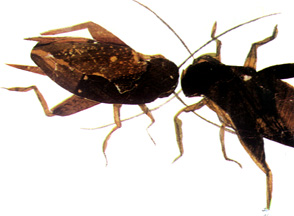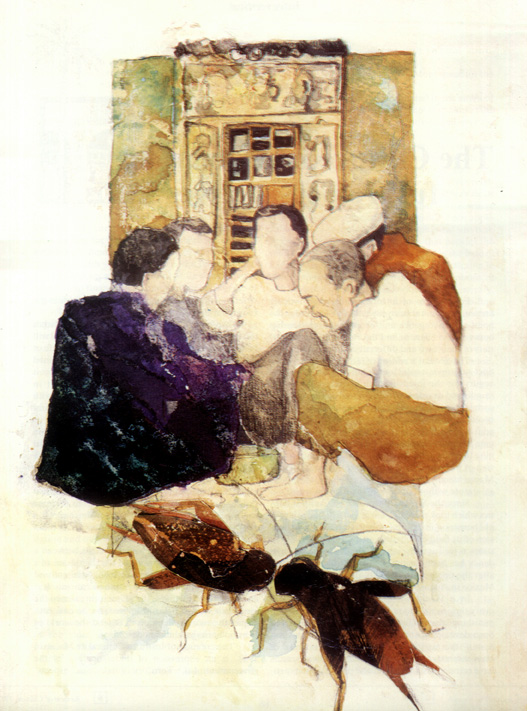Illustrations by Victor Marreiros
"Gambling and betting are, for the Chinese, the greatest
amusements in life. In casinos or at home, on side-walks or on
garden benches, comfortably sitting or simply squatting,
Chinese from all walks of life bet on almost everything even
on cricket fights which take place yearly at the beginning of
Autumn, i. e., during the Lap-t'chau period (the seventh moon)".
The crickets are caught by farmers during the summer months or at the beginning of Autumn, with the aim of placing them in the "arena" to fight out.
The "cricket chirping near the fireplace" of the folk songs and tales can be found in every rural house and in every field of the world. This insect procreates unremittingly and any colony may include specimens of all ages.
The females have a long ovipositor with the shape of a tube, through which they expel the eggs inside the crevices. The female crickets living in the open lay their eggs under the soil. The eggs crackopen after 15 to 25 days at a temperature between 25 to 30 degrees and the growth of the nymph takes the same length of time. The crickets are generally nocturnal and woo the females in the evening and throughout the night. While they woo, they produce a sharp, shrill sound by rubbing together their fore wings.
The house crickets are omnivorous and they eat any kind of organic substances they find, while the field crickets (the Teleogryllus and Grillus species) eat vegetables such as potatoes, lettuce, carrots and all kinds of herbs.
The cricket nymph is very similar to the grown-up species, but smaller. Its wings and body keep growing and it moults its skin until it becomes a grown-up insect.
The house crickets do not get used to captivity and are in great demand. There are many different types all known under different names.
The males are extremelly aggressive to each other and they fight to set up the group's hierarchy and leadership. Although they fight while free, they very rarely hurt each other; but it is different when they fight in the "arena": the defeated either gives up or die.
Farmers catch the field crickets, which are very pugnacious, in their dens, while they hibernate. The farmer uses a small cylindric basket and places it in the burrow opening. Afterwards, he burns, near the opening, some straw or dry leaves, smoke enters the hibernacle forcing the cricket to leave and enter the small basket. Very often, the smoke forces the snakes to come out too. The insects caught in these conditions are the most expensive and they can cost thousands of patacas. The Chinese believe that the crickets caught this way are very good fighters, because even the snake fears to devour them in their dens. This is false, because the snake, while hibernating, does not eat; it only drinks, now and then, some water, if it can find it nearby.
The crickets caught in the districts of Soi-Seng, T'cheng-Un, T'cheong-Fa and Kou-I are the favourite, because their chirping is rather shrill and can be heard from far away.
The most wanted species are those known under the following names: Pac-ma-tau (white-head horse), Vong-ma-tau (yellow-head horse), Hac-ma-tau (black-head horse), Hai-Kim (crab claws) and Hak--ngan (black eyes).
The keeping of these insects is very expensive and requires much care from the breeder, because the smallest negligence may cause sickness and death.
In ancient times, more than 3,000 years ago, the Chinese emperors bred these insects in highly precious cages made out of gold, silver, ivory, jade or crystal and each animal was treated by an "herb doctor".
In each cage, the breeders put a small pot with mineral water to quench the insect's thirst and fed it the opening, some straw or dry leaves, smoke enters the hibernacle rots, cabbage and cooked rice of first quality to which some honey was added, so that the insect might become heavier, stronger and more pugnacious.
If an insect should get sick, the "doctor" would feed it some mosquito larvae, dried in the sun, mixed together with some medicinal herbs. But crushed sprouts of wild peas were the most powerful medicine. Besides all these precautions, the most important was the preparation of the insect's sexual life.
Thus, every night, the "doctor" had to put in each cage, near the male, a female that was taken out some hours later. It was not allowed to smoke cigarettes or opium in the room where the crickets were bred, because the smoke ruins the insect's health and may render it unable to fight.
Long before the beginning of the fight, the punters arrive with one or more pots with crickets, which are placed on a long table. These pots are completely shut with a piece of card board covered with red paper. Every pot has the owner's engraved name, so that no mistake may occur.
A man acting as supervisor weighs the insects in a analytical balance. Preferably, the insects must have the same weight, but in very special cases and with the approval of the public, there may be a slight difference in grams. The same man is also the referee during the fight and there can be no complaints about his decisions.
After the insects have been weighed and their physical disposition examined, two of them are put in the pot that will be the "arena".
Afterwards, the cricket owners rub the insects'back with a stick which has at its end some mouse whiskers or hairs. This makes the crickets mad. Then, the insects fight desperately until one of them is totally torn to pieces, with no legs or head. It may happen that during the fight, one of the insects refuses to fight walking back whenever its opponent stretches out its feet to catch it. When this happens, the decision is left to the referee.
Twenty per cent of the bet income belong to the house owner and the winners are offered, as a gift, one or several red banners with words of praise for the victorious cricket.
Afterwards, processions with large attendance from enthusiasts go along the city streets carrying the insect to its owner's house.

There is no cash seen in the bets, but only the offering of roasted piglings or cakes. The money is later given to the punters in a certain place and the total amount may reach hundreds of thousands patacas.
Formerly, when a victorious cricket died, news would be published in the newspapers proclaiming the exact hour of its "funeral" which a lot of people would assemble. The burial place should also have a good "fong-soi" just as the one chosen to bury a person.
In the past, this kind of amusement was performed in several places, preferably in hotels or in houses of wealthy Chinese families.
Nowadays, the crickets fight takes place in an old house in Travessa dos Anjos, 24, G/F, every afternoon between 2 p. m. and 5 p. m.
Photos are not allowed to be taken during the fight, because the sudden brightness of the "flash" stuns the animal, hindering it to carry on the fight.
Translated by Lúcia Pombeiro

Illustraions by Victor Marreiros © Copyright 1987
*Scholar and publicist of Macau
start p. 83
end p.